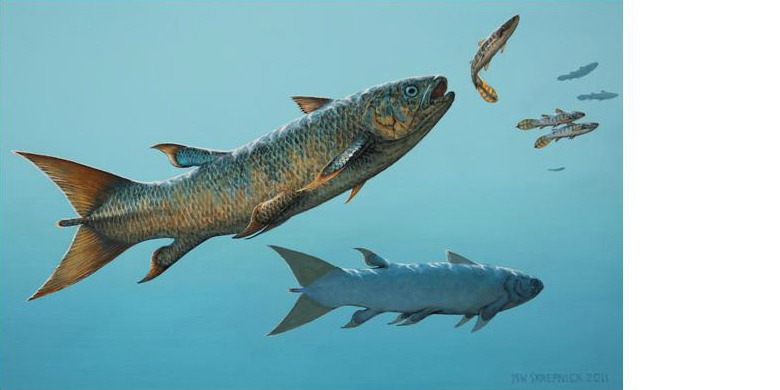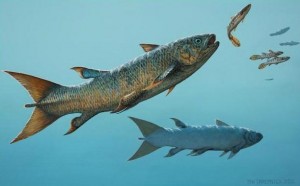
May 3, 2012

The following is a press release from the University of Alberta about a new fossil coelacanth discovery.
+++++
Coelacanths, an ancient group of fishes that were once thought to exist only in fossils, made headlines in 1938 when one of their modern relatives was pulled alive from the ocean. Now coelacanths are making another splash—and University of Alberta researchers are responsible for the discovery.
Lead U of A researcher Andrew Wendruff identified coelacanth fossils that he says are so dramatically different from previous finds, they shatter the theory that coelacanth evolution was stagnant in that their body shape and lifestyle changed little since the origin of the group.
Wendruff says his one-metre-long, fork-tailed coelacanth was one of an “offshoot” lineage that lived 240 million years ago. It falls between the earliest coelacanth fossils dating back 410 million years and the latest fossils dated about 75 million years ago, near the end of the age of dinosaurs.
“Our coelacanth had a forked tail, indicating it was a fast-moving, aggressive predator, which is very different from the shape and movement of all other coelacanths in the fossil record,” said Wendruff.
The researchers say all other ancient coelacanth fossils, and even the modern living coelacanths, have very different bodies.
The first modern coelacanth, or “living fossil,” was captured 74 years ago off the coast of South Africa. Since then, others have been caught in southern oceans near the Comoros Islands, Tanzania and Indonesia.
The fork-tailed fossils described by the U of A team were found in the Rocky Mountains near Tumbler Ridge, British Columbia. Wilson says the eastern range of the Rockies 240 million years ago was a very different place from what it is today. “The area was underwater, lying off the western coast of the supercontinent Pangaea.”
Wendruff’s research co-author, U of A professor emeritus Mark Wilson, describes typical coelacanths as having chunky bodies, fins of varying size and broad, flexible tails. “These fish were slow-moving and probably lay in wait for their prey,” said Wilson.
Wendruff’s coelacanth is so different from all others that it’s been given its own name, Rebellatrix, which means “rebel coelacanth.” The researchers say Rebellatrix came along after the end-Permian mass extinction 250 million years ago, an event so lethal it wiped out 90 per cent of marine life.
Rebellatrix filled a previously occupied predator niche, but it didn’t fare well.
“Rebellatrix was likely a spectacular failure in the evolution of cruising predation,” said Wendruff. “Clearly, some other fish groups with forked tails must have outperformed this coelacanth, as it does not appear later in the fossil record.” Wilson notes that one group of fishes that may have outperformed Rebellatrix were sharks, fossils of which were found in the same rocks.
The research by Wendruff and Wilson was published May 2 as the cover article in the Journal of Vertebrate Paleontology.

About Loren Coleman
Loren Coleman is one of the world’s leading cryptozoologists, some say “the” leading living cryptozoologist. Certainly, he is acknowledged as the current living American researcher and writer who has most popularized cryptozoology in the late 20th and early 21st centuries.
Starting his fieldwork and investigations in 1960, after traveling and trekking extensively in pursuit of cryptozoological mysteries, Coleman began writing to share his experiences in 1969. An honorary member of Ivan T. Sanderson’s Society for the Investigation of the Unexplained in the 1970s, Coleman has been bestowed with similar honorary memberships of the North Idaho College Cryptozoology Club in 1983, and in subsequent years, that of the British Columbia Scientific Cryptozoology Club, CryptoSafari International, and other international organizations. He was also a Life Member and Benefactor of the International Society of Cryptozoology (now-defunct).
Loren Coleman’s daily blog, as a member of the Cryptomundo Team, served as an ongoing avenue of communication for the ever-growing body of cryptozoo news from 2005 through 2013. He returned as an infrequent contributor beginning Halloween week of 2015.
Coleman is the founder in 2003, and current director of the International Cryptozoology Museum in Portland, Maine.
Filed under Breaking News, Coelacanth, CryptoZoo News